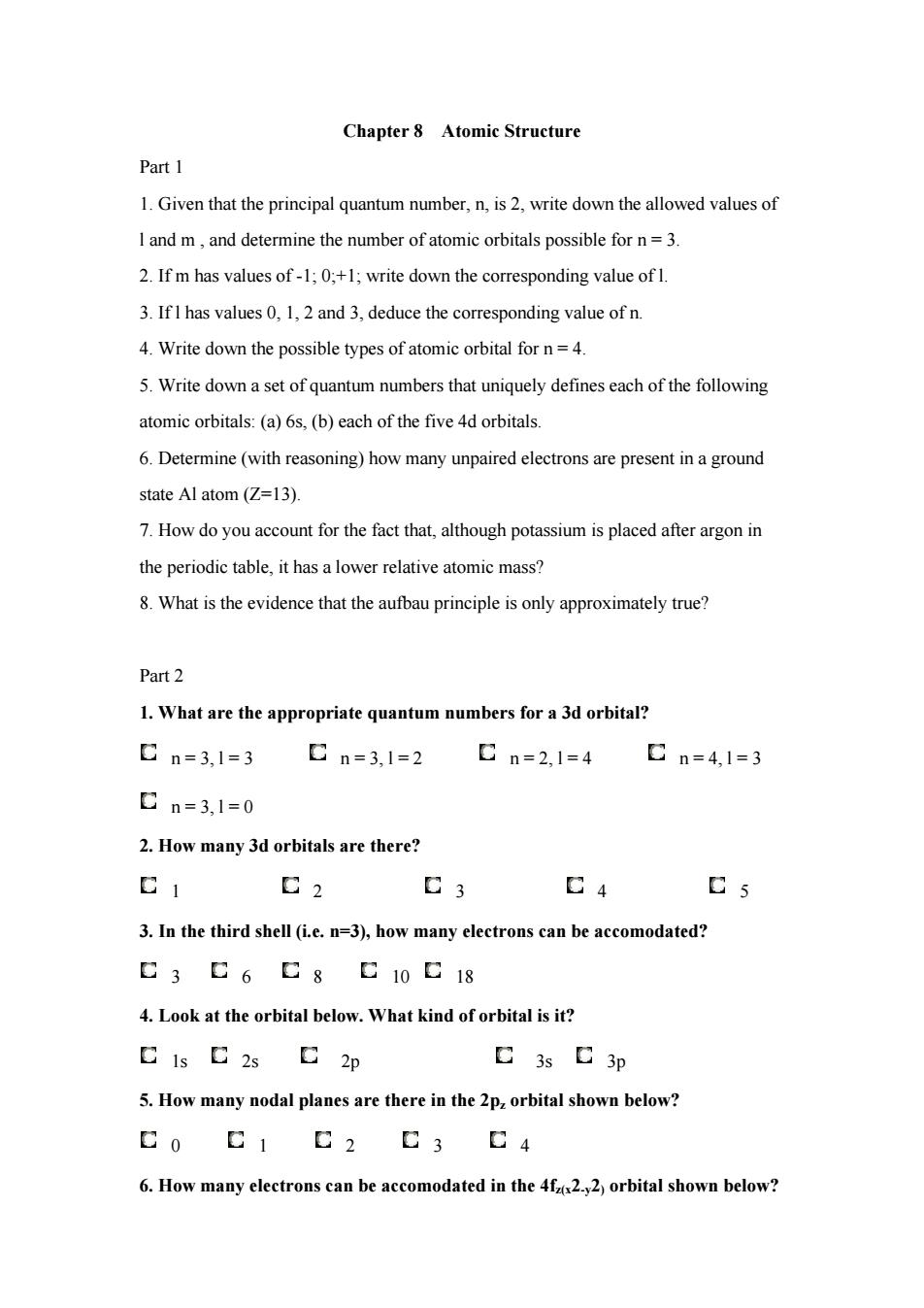
Chapter 8 Atomic Structure Part 1 1.Given that the principal quantum number,n,is2,write down the allowed values of I and m,and determine the number of atomic orbitals possible for n=3. 2.If m has values of-1:0:+1;write down the corresponding value of 1. 3.If l has values 0,1,2 and 3,deduce the corresponding value of n. 4.Write down the possible types of atomic orbital for n=4. 5.Write down a set of quantum numbers that uniquely defines each of the following atomic orbitals:(a)6s,(b)each of the five 4d orbitals. 6.Determine(with reasoning)how many unpaired electrons are present in a ground state Al atom(Z=13). 7.How do you account for the fact that,although potassium is placed after argon in the periodic table,it has a lower relative atomic mass? 8.What is the evidence that the aufbau principle is only approximately true? Part2 1.What are the appropriate quantum numbers for a 3d orbital? 0n=3,1=3 0n=3,1=2 0n=2.1=4Cn=4,1=3 0n=3,1=0 2.How many 3d orbitals are there? C1 02 03 04 05 3.In the third shell (i.e.n=3),how many electrons can be accomodated? 0306C8C10018 4.Look at the orbital below.What kind of orbital is it? 01s02s C 2p C3s C 3p 5.How many nodal planes are there in the 2p,orbital shown below? 0001 0203C4 6.How many electrons can be accomodated in the 4f(2.,2)orbital shown below?
Chapter 8 Atomic Structure Part 1 1. Given that the principal quantum number, n, is 2, write down the allowed values of l and m , and determine the number of atomic orbitals possible for n = 3. 2. If m has values of -1; 0;+1; write down the corresponding value of l. 3. If l has values 0, 1, 2 and 3, deduce the corresponding value of n. 4. Write down the possible types of atomic orbital for n = 4. 5. Write down a set of quantum numbers that uniquely defines each of the following atomic orbitals: (a) 6s, (b) each of the five 4d orbitals. 6. Determine (with reasoning) how many unpaired electrons are present in a ground state Al atom (Z=13). 7. How do you account for the fact that, although potassium is placed after argon in the periodic table, it has a lower relative atomic mass? 8. What is the evidence that the aufbau principle is only approximately true? Part 2 1. What are the appropriate quantum numbers for a 3d orbital? n = 3, l = 3 n = 3, l = 2 n = 2, l = 4 n = 4, l = 3 n = 3, l = 0 2. How many 3d orbitals are there? 1 2 3 4 5 3. In the third shell (i.e. n=3), how many electrons can be accomodated? 3 6 8 10 18 4. Look at the orbital below. What kind of orbital is it? 1s 2s 2p 3s 3p 5. How many nodal planes are there in the 2pz orbital shown below? 0 1 2 3 4 6. How many electrons can be accomodated in the 4fz(x2-y2) orbital shown below?
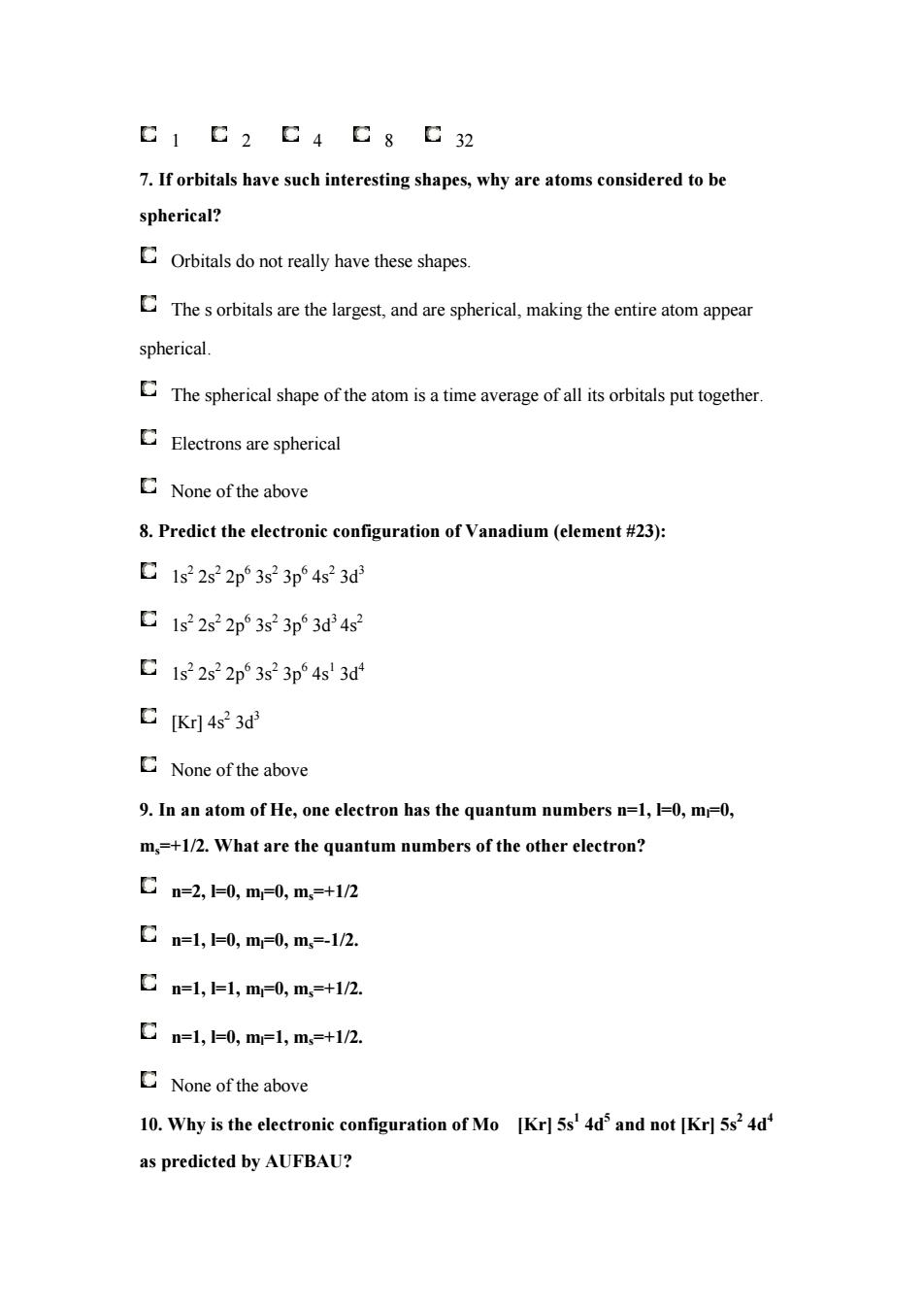
0102口408032 7.If orbitals have such interesting shapes,why are atoms considered to be spherical? Orbitals do not really have these shapes. Therbitals are the argest and are spherical,making theentiremappear spherical The spherical shape of of all put together Electrons are spherical None of the above 8.Predict the electronic configuration of Vanadium(element #23): 1s 2s22p 3s 3p 4s2 3d C1s22s22p53s23p53d34s2 口1522s22p53s23p4s'3对 C[Kr]4s3d None of the above 9.In an atom of He,one electron has the quantum numbers n=1,1=0,m0, m,+1/2.What are the quantum numbers of the other electron? Cn2,0,m-0,m,=+1/2 C=l,0,m-0,m,-1n. C=L,1,m-0,m=+12. C n=1,1-0,mr-1,m-+1/2. None of the above 10.Why is the electronic configuration of Mo [Kr]5s'4dand not [Kr]5s4d as predicted by AUFBAU?
1 2 4 8 32 7. If orbitals have such interesting shapes, why are atoms considered to be spherical? Orbitals do not really have these shapes. The s orbitals are the largest, and are spherical, making the entire atom appear spherical. The spherical shape of the atom is a time average of all its orbitals put together. Electrons are spherical None of the above 8. Predict the electronic configuration of Vanadium (element #23): 1s2 2s2 2p6 3s2 3p6 4s2 3d3 1s2 2s2 2p6 3s2 3p6 3d3 4s2 1s2 2s2 2p6 3s2 3p6 4s1 3d4 [Kr] 4s2 3d3 None of the above 9. In an atom of He, one electron has the quantum numbers n=1, l=0, ml=0, ms=+1/2. What are the quantum numbers of the other electron? n=2, l=0, ml=0, ms=+1/2 n=1, l=0, ml=0, ms=-1/2. n=1, l=1, ml=0, ms=+1/2. n=1, l=0, ml=1, ms=+1/2. None of the above 10. Why is the electronic configuration of Mo [Kr] 5s1 4d5 and not [Kr] 5s2 4d4 as predicted by AUFBAU?
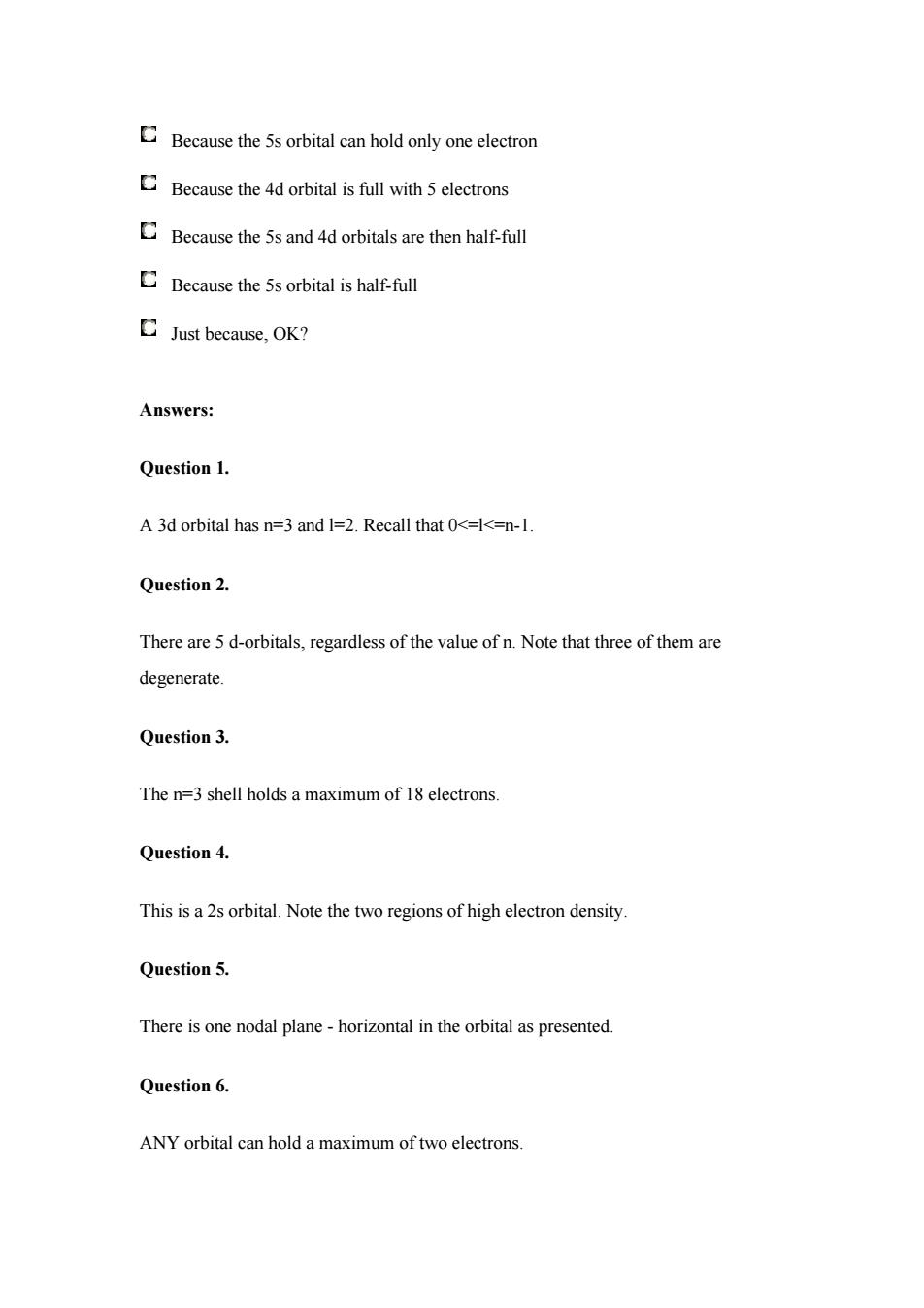
Because the 4d orbital is full with 5 electrons Because the 5sand obits are then half-full Because the 5s orbital is half-ful Just because,OK? Answers: Question I. A 3d orbital has n=3 and I=2.Recall that 0<=I<=n-1. Question 2 There are 5 d-orbitals,regardless of the value of n.Note that three of them are degenerate. Question 3. The n=3 shell holds a maximum of 18 electrons Question 4. This is a 2s orbital.Note the two regions of high electron density. Question 5. There is one nodal plane-horizontal in the orbital as presented. Question 6. ANY orbital can hold a maximum of two electrons
Because the 5s orbital can hold only one electron Because the 4d orbital is full with 5 electrons Because the 5s and 4d orbitals are then half-full Because the 5s orbital is half-full Just because, OK? Answers: Question 1. A 3d orbital has n=3 and l=2. Recall that 0<=l<=n-1. Question 2. There are 5 d-orbitals, regardless of the value of n. Note that three of them are degenerate. Question 3. The n=3 shell holds a maximum of 18 electrons. Question 4. This is a 2s orbital. Note the two regions of high electron density. Question 5. There is one nodal plane - horizontal in the orbital as presented. Question 6. ANY orbital can hold a maximum of two electrons
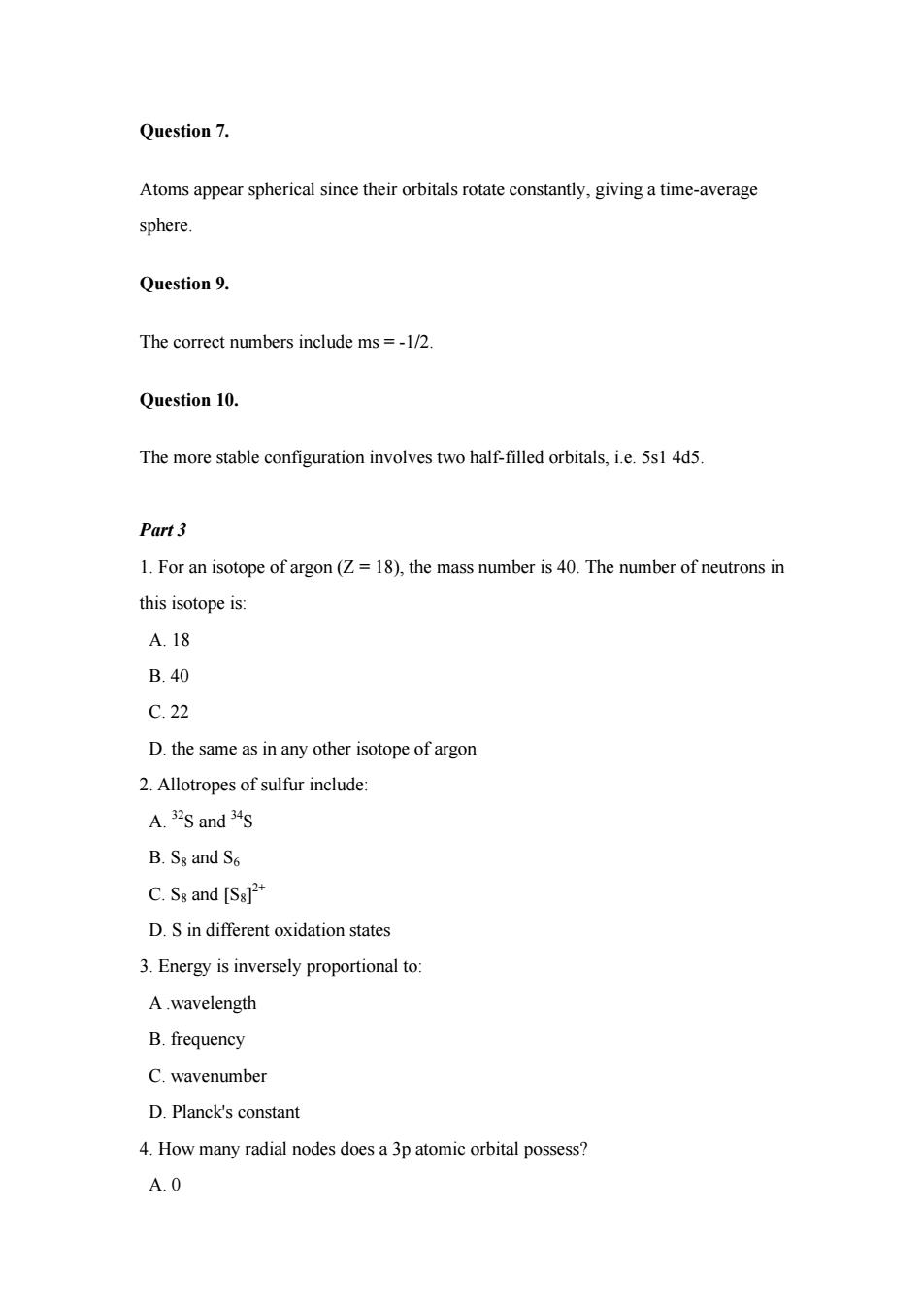
Question 7. Atoms appear spherical since their orbitals rotate constantly,giving a time-average sphere. Question9 The correct numbers include ms=-1/2. Question 10. The more stable configuration involves two half-filled orbitals,i.e.5s1 4d5. Part3 1.For an isotope of argon(Z=18),the mass number is 40.The number of neutrons in this isotope is: A.18 B.40 C.22 D.the same as in any other isotope of argor 2.Allotropes of sulfur include: A.3S andS B.Ss and So C.Ss and [Ss D.Sin different oxidation states 3.Energy is inversely proportional to A.wavelength B.frequency C.wavenumber D.Planck's constant 4.How many radial nodes does a 3p atomic orbital possess? A.0
Question 7. Atoms appear spherical since their orbitals rotate constantly, giving a time-average sphere. Question 9. The correct numbers include ms = -1/2. Question 10. The more stable configuration involves two half-filled orbitals, i.e. 5s1 4d5. Part 3 1. For an isotope of argon (Z = 18), the mass number is 40. The number of neutrons in this isotope is: A. 18 B. 40 C. 22 D. the same as in any other isotope of argon 2. Allotropes of sulfur include: A. 32S and 34S B. S8 and S6 C. S8 and [S8] 2+ D. S in different oxidation states 3. Energy is inversely proportional to: A .wavelength B. frequency C. wavenumber D. Planck's constant 4. How many radial nodes does a 3p atomic orbital possess? A. 0
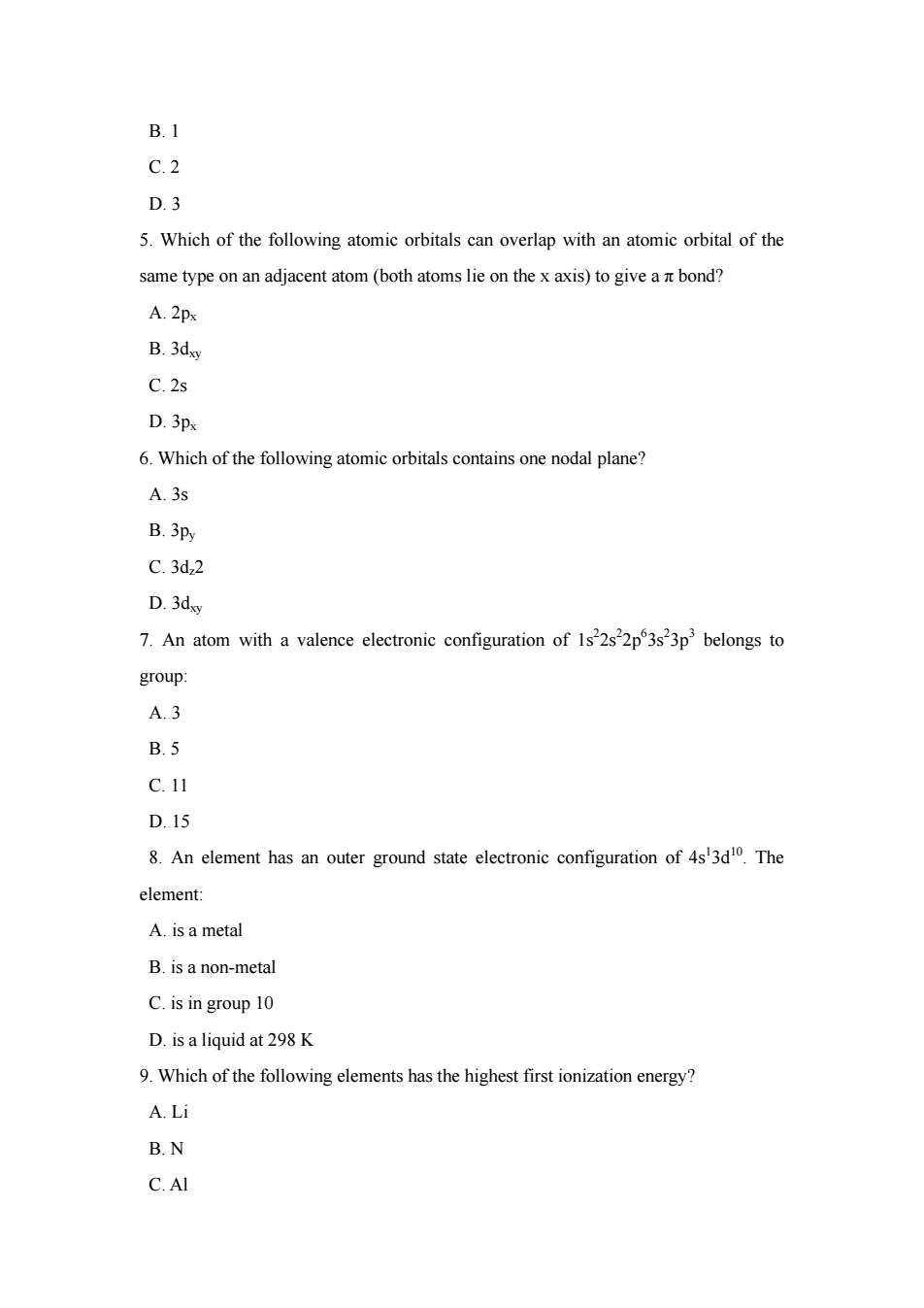
B.1 C.2 D.3 5.Which of the following atomic orbitals can overlap with an atomic orbital of the same type on an adjacent atom(both atoms lie on the x axis)to give a x bond? A.2px B.3dxy C.2s D.3px 6.Which of the following atomic orbitals contains one nodal plane? A.3s B.3py C.3d2 D.3d 7.An atom with a valence electronic configuration of belongs to group: A.3 B.5 C.11 D.15 8.An element has an outer ground state electronic configuration of 4s'3d The element: A.is a metal B.is a non-metal C.is in group 10 D.is a liquid at 298 K 9.Which of the following elements has the highest first ionization energy? A.Li B.N C.Al
B. 1 C. 2 D. 3 5. Which of the following atomic orbitals can overlap with an atomic orbital of the same type on an adjacent atom (both atoms lie on the x axis) to give a π bond? A. 2px B. 3dxy C. 2s D. 3px 6. Which of the following atomic orbitals contains one nodal plane? A. 3s B. 3py C. 3dz2 D. 3dxy 7. An atom with a valence electronic configuration of 1s2 2s2 2p6 3s2 3p3 belongs to group: A. 3 B. 5 C. 11 D. 15 8. An element has an outer ground state electronic configuration of 4s1 3d10. The element: A. is a metal B. is a non-metal C. is in group 10 D. is a liquid at 298 K 9. Which of the following elements has the highest first ionization energy? A. Li B. N C. Al
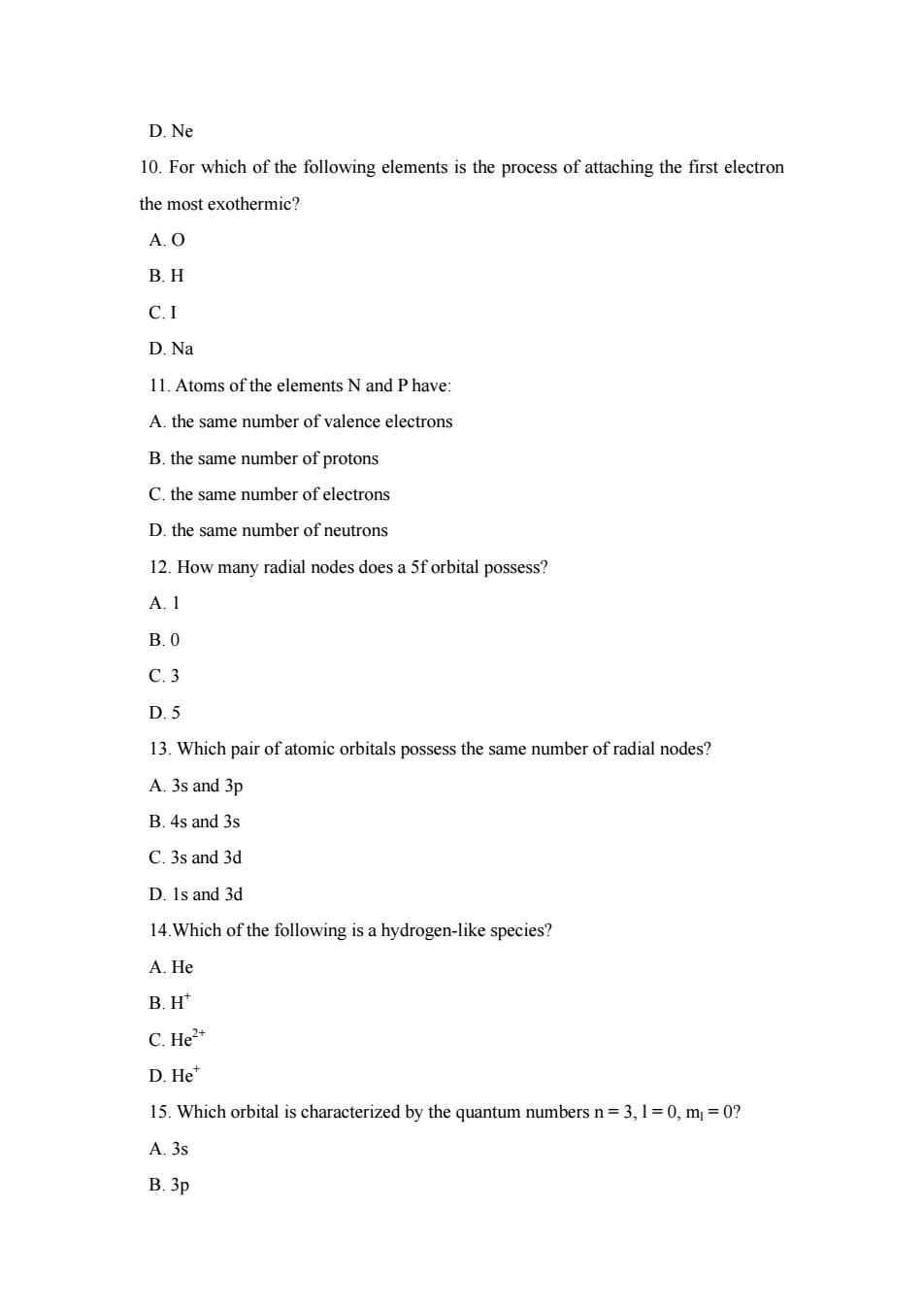
D.Ne 10.For which of the following elements is the process of attaching the first electron the most exothermic? A.0 B.H C.I D.Na 11.Atoms ofthe elements N and P have: A.the same number of valence electrons B.the same number of protons C.the same number ofelectrons D.the same number of neutrons 12.How many radial nodes does a 5f orbital possess? A.1 B.0 C.3 D.5 13.Which pair of atomic orbitals possess the same number of radial nodes? A.3s and 3p B.4s and 3s C.3sand 3d D.Is and 3d 14.Which of the following is a hydrogen-like species? A.He B.H C.He2 D.He* 15.Which orbital is characterized by the quantum numbersn=3,1=0,m=0? A.3s B.3p
D. Ne 10. For which of the following elements is the process of attaching the first electron the most exothermic? A. O B. H C. I D. Na 11. Atoms of the elements N and P have: A. the same number of valence electrons B. the same number of protons C. the same number of electrons D. the same number of neutrons 12. How many radial nodes does a 5f orbital possess? A. 1 B. 0 C. 3 D. 5 13. Which pair of atomic orbitals possess the same number of radial nodes? A. 3s and 3p B. 4s and 3s C. 3s and 3d D. 1s and 3d 14.Which of the following is a hydrogen-like species? A. He B. H+ C. He2+ D. He+ 15. Which orbital is characterized by the quantum numbers n = 3, l = 0, ml = 0? A. 3s B. 3p

C.3d D.2s 16.In its ground state,an Hion has A.two spin-paired electrons B.two electrons with parallel spins C.two electrons in different orbitals D.one electron 17.An element with a valence electron configuration of ns'npbelongs to which group? A.3 B.5 C.13 D.15 18.Br has two naturally occurring isotopes,approximately50%each ofBr and sBr.In the mass spectrum of naturally occurring dibromine,the parent ion will appear as: A.two peaks of equal intensity B.three peaks of equal intensity C.three peaks with an approximate intensity ratio 1:2:1 D.one peak 19 In the emission spectrum of hydrogen,which series of emission lines falls in the visible region? A.Lyman B.Paschen C.Balmer D.Pfund 20.The first ionization energy of Na is 496 kJ molGive this value ineV if 1 eV= 96.485 kJ mol,paying attention to significant figures. A.5.14cV B.5.1407eV
C. 3d D. 2s 16. In its ground state, an H- ion has: A. two spin-paired electrons B. two electrons with parallel spins C. two electrons in different orbitals D. one electron 17. An element with a valence electron configuration of ns2 np3 belongs to which group? A. 3 B. 5 C. 13 D. 15 18. Br has two naturally occurring isotopes, approximately 50% each of 79Br and 81Br. In the mass spectrum of naturally occurring dibromine, the parent ion will appear as: A. two peaks of equal intensity B. three peaks of equal intensity C. three peaks with an approximate intensity ratio 1 : 2 : 1 D. one peak 19 In the emission spectrum of hydrogen, which series of emission lines falls in the visible region? A. Lyman B. Paschen C. Balmer D. Pfund 20. The first ionization energy of Na is 496 kJ mol-1. Give this value in eV if 1 eV = 96.485 kJ mol-1, paying attention to significant figures. A. 5.14 eV B. 5.1407 eV
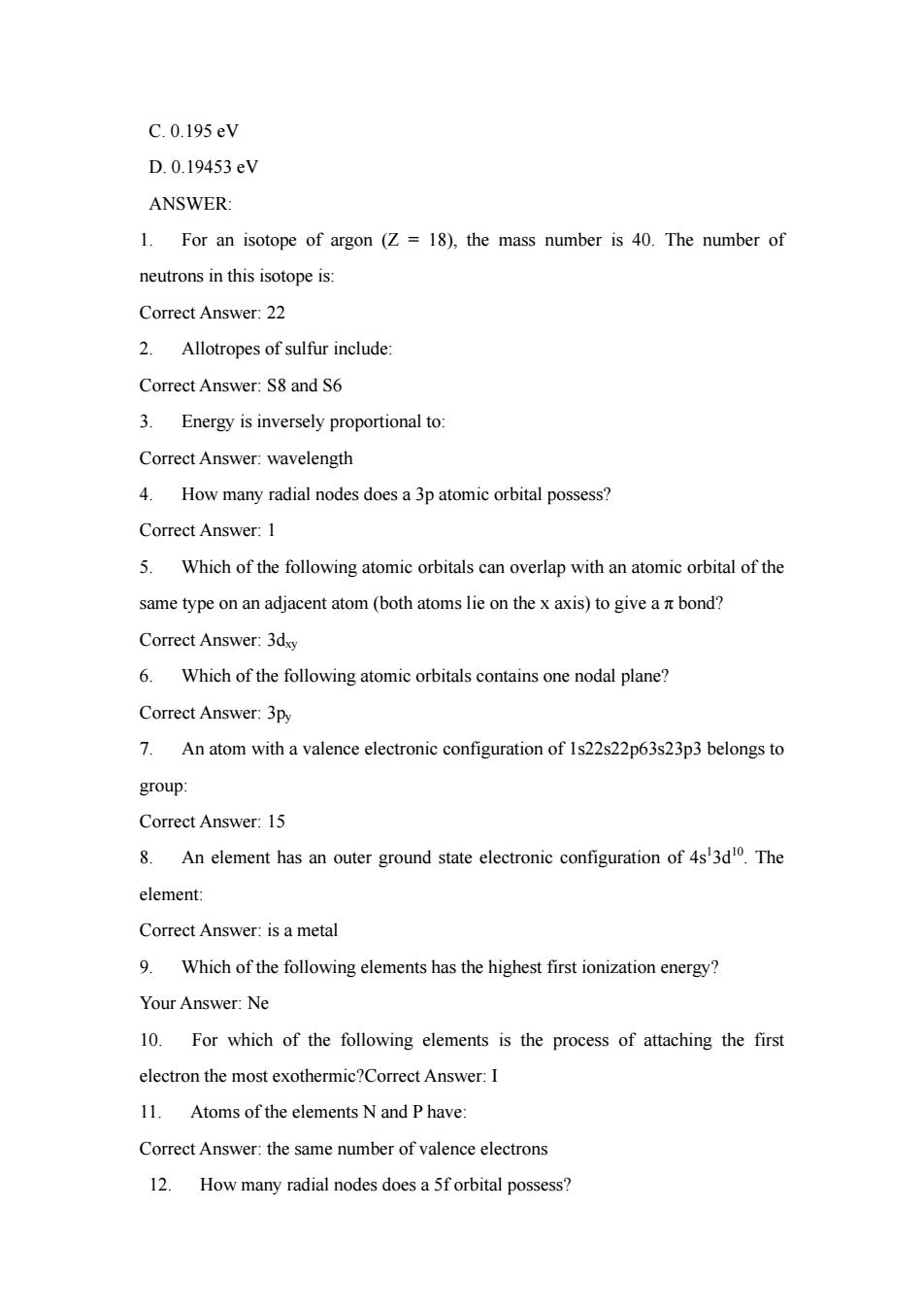
C.0.195eV D.0.19453eV ANSWER: 1.For an isotope of argon (Z=18).the mass number is 40.The number of neutrons in this isotope is: Correct Answer:22 2.Allotropes of sulfur include Correct Answer:S8 and S6 3.Energy is inversely proportional to: Correct Answer:wavelength 4.How many radial nodes does a 3p atomic orbital possess? Correct Answer:1 5.Which of the following atomic orbitals can overlap with an atomic orbital of the same type on an adjacent atom(both atoms lie on the x axis)to give a bond? Correct Answer:3dy 6.Which of the following atomic orbitals contains one nodal plane? Correct Answer:3p 7.An atom with a valence electronic configuration of 1s22s22p63s23p3 belongs to group: Correct Answer:15 8.An element has an outer ground state electronic configuration of 4s'3d.The element Correct Answer:is a metal 9.Which of the following elements has the highest first ionization energy? Your Answer:Ne 10.For which of the following elements is the process of attaching the first electron the most exothermic?Correct Answer:I 11.Atoms of the elements N and P have: Correct Answer:the same number of valence electrons 12.How many radial nodes does a 5f orbital possess?
C. 0.195 eV D. 0.19453 eV ANSWER: 1. For an isotope of argon (Z = 18), the mass number is 40. The number of neutrons in this isotope is: Correct Answer: 22 2. Allotropes of sulfur include: Correct Answer: S8 and S6 3. Energy is inversely proportional to: Correct Answer: wavelength 4. How many radial nodes does a 3p atomic orbital possess? Correct Answer: 1 5. Which of the following atomic orbitals can overlap with an atomic orbital of the same type on an adjacent atom (both atoms lie on the x axis) to give a π bond? Correct Answer: 3dxy 6. Which of the following atomic orbitals contains one nodal plane? Correct Answer: 3py 7. An atom with a valence electronic configuration of 1s22s22p63s23p3 belongs to group: Correct Answer: 15 8. An element has an outer ground state electronic configuration of 4s1 3d10. The element: Correct Answer: is a metal 9. Which of the following elements has the highest first ionization energy? Your Answer: Ne 10. For which of the following elements is the process of attaching the first electron the most exothermic?Correct Answer: I 11. Atoms of the elements N and P have: Correct Answer: the same number of valence electrons 12. How many radial nodes does a 5f orbital possess?
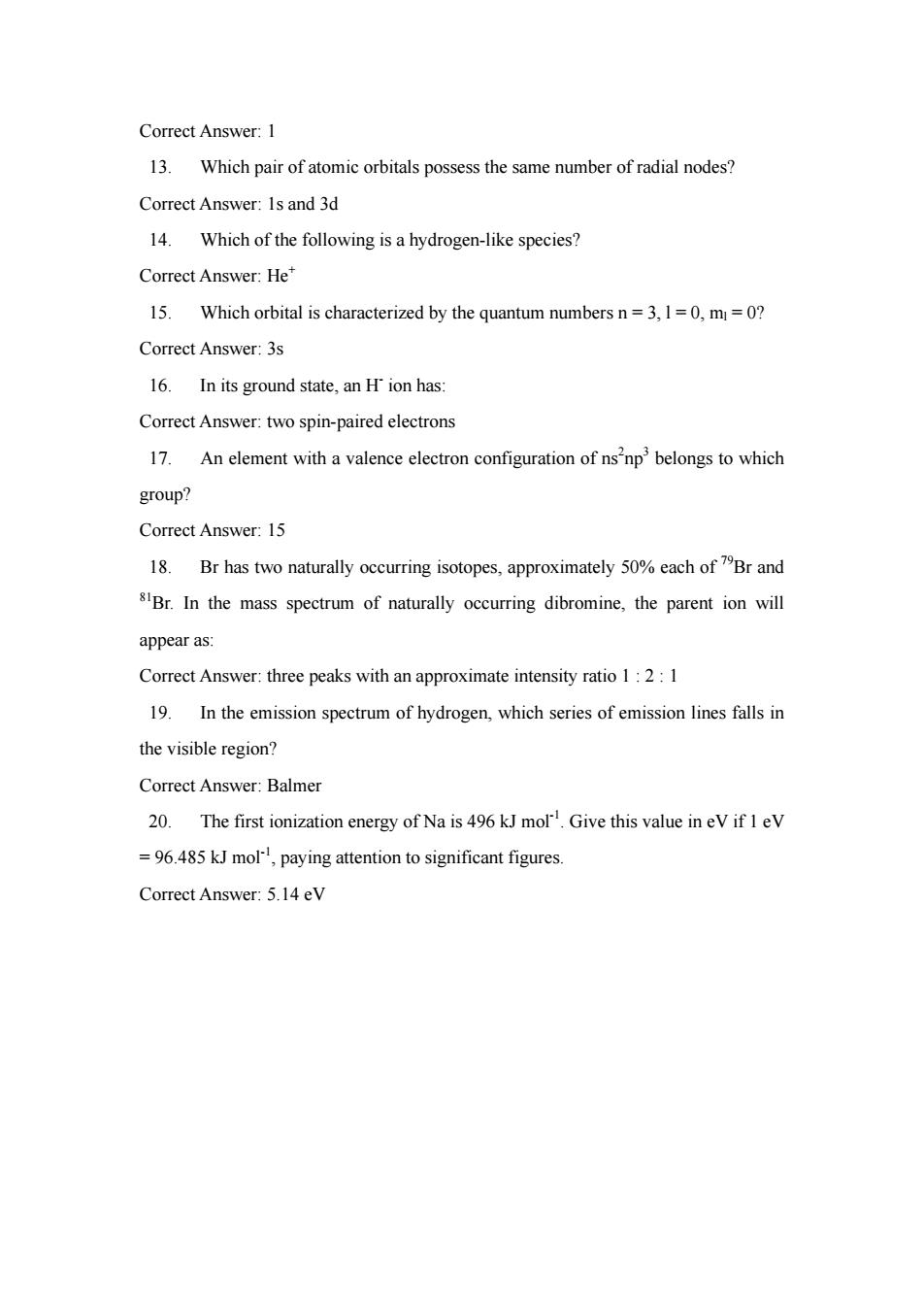
Correct Answer:1 13.Which pair of atomic orbitals possess the same number of radial nodes? Correct Answer:Is and 3d 14.Which of the following is a hydrogen-like species? Correct Answer:He' 15.Which orbital is characterized by the quantum numbers n=3,1=0,m=0? Correct Answer:3s 16.In its ground state,an Hion has: Correct Answer:two spin-paired electrons 17.An element with a valence electron configuration of ns'np belongs to which group? Correct Answer:15 18.Br has two naturally occurring isotopes,approximately 50%each of"Br and 8Br.In the mass spectrum of naturally occurring dibromine,the parent ion will appear as: Correct Answer:three peaks with an approximate intensity ratio 1:2:1 19.In the emission spectrum of hydrogen,which series of emission lines falls in the visible region? Correct Answer:Balmer 20.The first ionization energy of Na is 496 kJ mol Give this value in eV if I eV =9.485 kJmol paying attention to significant figures. Correct Answer:5.14eV
Correct Answer: 1 13. Which pair of atomic orbitals possess the same number of radial nodes? Correct Answer: 1s and 3d 14. Which of the following is a hydrogen-like species? Correct Answer: He+ 15. Which orbital is characterized by the quantum numbers n = 3, l = 0, ml = 0? Correct Answer: 3s 16. In its ground state, an H- ion has: Correct Answer: two spin-paired electrons 17. An element with a valence electron configuration of ns2 np3 belongs to which group? Correct Answer: 15 18. Br has two naturally occurring isotopes, approximately 50% each of 79Br and 81Br. In the mass spectrum of naturally occurring dibromine, the parent ion will appear as: Correct Answer: three peaks with an approximate intensity ratio 1 : 2 : 1 19. In the emission spectrum of hydrogen, which series of emission lines falls in the visible region? Correct Answer: Balmer 20. The first ionization energy of Na is 496 kJ mol-1. Give this value in eV if 1 eV = 96.485 kJ mol-1, paying attention to significant figures. Correct Answer: 5.14 eV